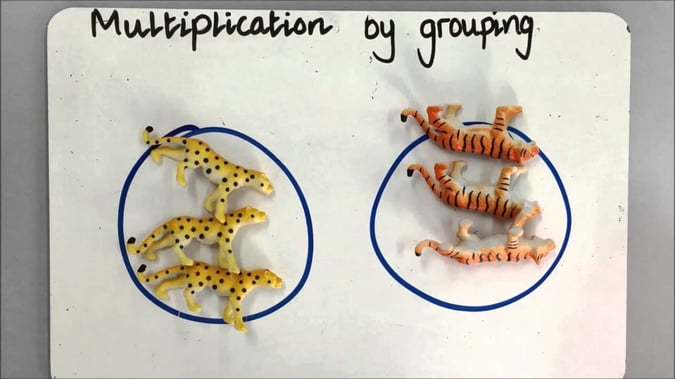Symptoms to Watch for and Ways to Help
People may fear things that confuse them, especially when it seems their peers have no difficulty understanding it. Math is no exception. Math phobia (also known as math anxiety) occurs when numbers in mathematical formulas seem like unsolvable riddles to students who haven’t mastered early math skills. These learners try to puzzle out an answer and come to the wrong conclusion, which means they feel discouraged. Sometimes, students grow afraid they will never be able to comprehend the subject. This is particularly true if students make mistakes several times in a row when they perceive their classmates never make errors. The good news is, there are ways to help these children by responding well and playing fun math games! This article explains symptoms to determine if your child has math phobia and – if she does have it - ways to overcome it.
Addressing symptoms with positive responses
Child's Symptom
The child makes excuses to avoid math assignments in school, such as asking to go to the bathroom or claiming to feel ill. These strategies to avoid the task could also happen at home, or the child may lie to family members and pretend not to have any math homework in the first place.
Adult’s Response
Calmly explain to the child why math is important to learn and how adults use it in daily life. Offer to help the child work through the problems slowly.
Child's Symptom
When pressured by an adult to do numerical formulas, the pupil becomes upset. This distress can be displayed by yelling, crying, or shutting down (putting head down, going mute, not making eye contact, etcetera).
Adult’s Response
Kindly acknowledge the child’s feelings and encourage calming down by taking deep breaths. Ask if there’s something that might make the environment more comfortable for working on math problems (low lighting, fidget toys, instrumental music, etcetera).
Child's Symptom
A student may insist others are “naturally good at math” while some people “just don’t get it,” labeling themselves in the latter category. This false belief that some individuals are hopeless results in a child being reluctant to attempt learning the material, as they view it as a waste of time and effort.
Adult’s Response
Dispel the incorrect, debilitating attitude by replacing it with a true, positive perspective. Remind the child it is not known how hard or often other students are working on math at home for things to appear “easy” for them at school. Acknowledge skills of all kinds (music, art, writing, math, etc.) come easier to some people than others, but emphasize anyone can learn to do anything when they try.
Child’s Symptom
The learner has had trouble with math in the past and continues to struggle.
Adult’s Response
Practice basic math skills from prior grade levels for which the child has a weak understanding to make it simpler for the child to master math skills of the current grade level.
Math games can bring refreshment to and fun for the discouraged math student
Math knowledge builds on itself, such as learning to multiply after learning to add. Students can’t learn the more complex skills taught in upper grades without having a strong base knowledge from lower grades. If children have a shaky comprehension of math, parents must act quickly to prevent them from falling behind.
Working with your child at home, and encouraging independent practice, is essential to master basic number sense. Of course, children do not want to do “extra homework,” but it doesn’t need to feel like work. Math games can make the practice fun!
Consider your child’s personality and learning style to choose ways to practice math that will be engaging
Consider your child’s personality and learning style to choose ways to practice math that will be engaging
- Artistic: Cut out shapes, angles, and fraction “pies” from colored construction paper.
- Musical: Look up songs about math topics on YouTube to dance and sing along.
- Linguistic: Create (or search the internet for) clever acronyms and phrases to make math rules easier to remember, such as PEMDAS for order of operations.
- Technological: Play free online games at websites such as CoolMath, ABCya, and Prodigy.
- Hands-On: Build structures using straws and tape or popsicle sticks and glue to learn 3-dimensional shapes and measure area and perimeter with a ruler.
- Interpersonal: Play flash cards or trivia board games with friends and relatives.
- Naturalistic: Go outdoors and collect a large amount of something small, like pebbles or leaves, and show how these are grouped when they are added, subtracted, multiplied, and divided. (This can be done with indoor objects, like paper clips or chocolate chips, if going outdoors is not preferred.)
Here is an example of a hands-on visual showing 2 groups of 3 items to teach 2 x 3 = 6:

A great resource along the way of your child’s Math education!
Please note, along the way of your child’s education, your child may need a Math tutor. 98thPercentile is here to help! A 98thPercentile math tutor can interact with your child live online, filling any skill gaps and building his or her strong foundational knowledge.
Math doesn’t need to be a scary riddle that induces math phobia in your child because it appears impossible to solve. Math can be a fun game your child enjoys!
Click here for more information.

 Students/Staff
Students/Staff Parents
Parents ElevatEd
ElevatEd












